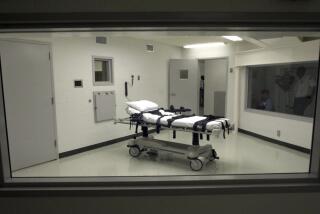48 on Texas’ Death Row Protest Their Isolation
HOUSTON — They’re among the least sympathetic people in Texas--death row inmates, incarcerated for some of the worst crimes imaginable. And ever since an escape two years ago, they’re also among the most closely confined. Moved into solo cells, they face 23 hours of solitude daily, with no human contact besides escorts to showers and exercise.
On Saturday, though, 48 of those inmates launched a “food strike,” joined by 200 inmates in similar conditions across Texas. Even for disruptive prisoners--and death row inmates aren’t always among them--indefinite, almost complete isolation is inhuman, the protesters say.
“Some of the men in there have been there over six months,” said prisoner advocate Gloria Rubac of the Texas Death Penalty Abolition Movement. “We got letters after they were there for a week, saying, ‘We can feel something is happening to our minds.’ They just want their sanity.”
The inmates are not the first to complain that Texas’ solitary confinement policies can cause mental illness. Last March, ruling on prison reforms begun two decades ago, a U.S. District Court judge called the state’s “administrative segregation” unconstitutional.
While most of the prison system, which had been under court supervision, was returned to state oversight, “ad seg” was not. “The pain and suffering caused by extreme levels of psychological deprivation are equally, if not more, cruel and unusual” than physical punishment, wrote Judge William Wayne Justice. The state is appealing.
Prison spokesman Larry Fitzgerald, however, downplayed both the food strike and the conditions prompting it. “All the guys at the Terrell Unit did have commissary food in their cells,” Fitzgerald said. “A hunger strike is when we can show they’ve gone for a prolonged period of time, 72 hours, without eating any food. This is a snaggletoothed affair, hit or miss; some will eat, some won’t.”
Technically, the death row protesters are not in solitary confinement, which refers to isolating prisoners for 14 days at most as a punishment. But semantics aside, the segregated inmates are effectively in solitary, said Wesley Johnson, a professor of criminal justice at Sam Houston State University.
The inmates’ conditions changed after seven inmates briefly escaped from Huntsville’s Ellis Unit. All had participated in a prison work program, could meet with other inmates and exercise in small groups.
An investigation blamed short-staffing and unusually free movement for the breakout. So officials began moving the unit’s death row inmates to their current, far more restrictive conditions at the Terrell Unit near Livingston. So far, about 130 have been moved; 460 others are in line to be transferred.
“The administration is between a rock and a hard place,” said Johnson. “They’ve got inmates who are threatening, challenging their authority to maintain order. On the other hand, they have people who they are exposing to very severe punishment” who have not merited it.
Two inmates have already filed federal court lawsuits regarding their conditions, Rubac said. But, she added, inmates started the food strike because such lawsuits can take decades to resolve. Although other states, including California, have faced critiques or suits for administrative segregation policies, Texas has the most inmates in “ad seg,” Johnson said. About 8,000 inmates are in some form of solitary confinement, either for their own protection or as punishment, he said.
More to Read
Sign up for Essential California
The most important California stories and recommendations in your inbox every morning.
You may occasionally receive promotional content from the Los Angeles Times.










